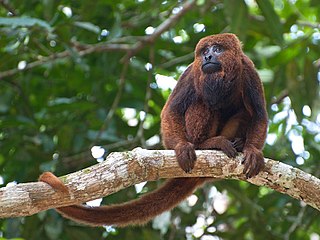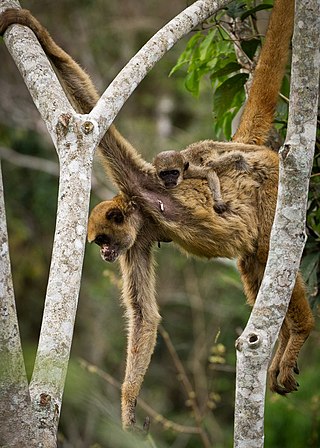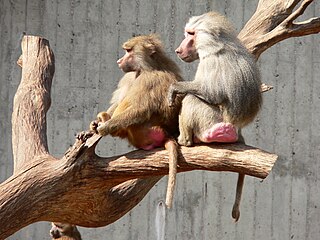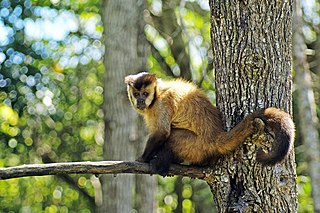
Howler monkeys are the most widespread primate genus in the Neotropics and are among the largest of the platyrrhines along with the muriquis (Brachyteles), the spider monkeys (Ateles) and woolly monkeys (Lagotrix). The monkeys are native to South and Central American forests. They are famous for their loud howls, which can be heard up to three miles away through dense rain forest. Fifteen species are recognized. Previously classified in the family Cebidae, they are now placed in the family Atelidae. They are primarily folivores but also significant frugivores, acting as seed dispersal agents through their digestive system and their locomotion. Threats include human predation, habitat destruction, illegal wildlife trade, and capture for pets or zoo animals.

The Atelidae are one of the five families of New World monkeys now recognised. It was formerly included in the family Cebidae. Atelids are generally larger monkeys; the family includes the howler, spider, woolly, and woolly spider monkeys. They are found throughout the forested regions of Central and South America, from Mexico to northern Argentina.

The brown howler, also known as brown howler monkey, is a species of howler monkey, a type of New World monkey that lives in forests in southeastern Brazil and far northeastern Argentina (Misiones). It lives in groups of two to 11 individuals. Despite the name "brown howler", it is notably variable in colour, with some individuals appearing largely reddish-orange or black.

The white-bellied spider monkey, also known as the white-fronted or long-haired spider monkey, is an endangered species of spider monkey, a type of New World monkey. It is found in the north-western Amazon in Colombia, Ecuador, Venezuela, Peru and Brazil, ranging as far south as the lower Ucayali River and as far east as the Branco River. In the past, the Peruvian, brown and white-cheeked spider monkeys have been treated as subspecies of A. belzebuth. As presently defined, the white-bellied spider monkey is monotypic. It has a whitish belly and a pale patch on the forehead, which, despite its common name, often is orange-buff, though this might be due to dirt and other stainers. They live in groups of 20 to 40 individuals, splitting into small parties of 1 to 9 when in activity.

The black-fronted titi monkey is a species of titi, a type of New World monkey.

The Peruvian spider monkey, also known as the black-faced black spider monkey, is a species of spider monkey that lives in Peru, as well as in Brazil and in Bolivia. At 60 centimetres long, they are relatively large among species of monkey, and their strong, prehensile tails can be up to 1 m (3 ft) long. Unlike many species of monkey, they have only a vestigial thumb, an adaptation which enables them to travel using brachiation. Peruvian spider monkeys live in groups of 20–30 individuals, but these groups are rarely all together simultaneously. The size and dynamics of the resulting subgroups vary with food availability and sociobehavioral activity. They prefer to eat fleshy fruit, but will change their diet in response to scarcity of ripe fruit. Individuals of this species also eat small animals, insects and leaves based on availability. Females separate from the band to give birth, typically in the fall. These females inhabit a group of core areas where resources are abundant in certain seasons. Typically, males exhibit ranging over longer distances than females, with movement of individuals enhancing the fluidity of subgroup size. Peruvian spider monkey are independent at about 10 months, with a lifespan of about 20 years.

The mantled howler is a species of howler monkey, a type of New World monkey, from Central and South America. It is one of the monkey species most often seen and heard in the wild in Central America. It takes its "mantled" name from the long guard hairs on its sides.

The Yucatán black howler, or Guatemalan black howler, is a species of howler monkey, a type of New World monkey, from Central America. It is found in Belize, Guatemala and Mexico, in and near the Yucatán Peninsula. It lives in evergreen, semideciduous and lowland rain forests. It is also known as the baboon in Belize, although it is not closely related to the baboons in Africa.

The northern muriqui is one of two species of muriqui. They are also known as woolly spider monkey because they exhibit the woollen pelt of woolly monkeys and the long prehensile tail of spider monkeys. Muriquis are the largest extant New World monkeys. They can reach 4.3 feet or 1.3 metres long and weight up to 7 to 10 kilograms. The northern muriqui is a critically endangered species, it is estimated that there are less than 1000 mature individuals in the wild. The species is unusual among primates in that they display egalitarian tendencies in their social relationships. This species is endemic to the Atlantic Forest region of Brazilian states of Rio de Janeiro, Espírito Santo, Minas Gerais and Bahia. Their diets, travel patterns and reproductive cycles are seasonally determined. The size of each group can fluctuate as females will move between groups of monkeys.

The southern muriqui is a muriqui species endemic to Brazil.

The blond capuchin is a species of capuchin monkey endemic to northeastern Brazil. This endangered species was rediscovered in 2006. It can live in exceptionally large groups of over 150 individuals, and like other capuchin species, exhibits a complex and high level of sociality. It is threatened by loss of habitat due to agriculture, primarily sugarcane fields. In many cases this has caused sugarcane to make up a large portion of their diet, which would otherwise consist of mostly fruit and small animals. The blond capuchin is known to inhabit both the Atlantic forest and Caatinga biomes, although the habitation of the Caatinga may be a recent choice caused by human encroachment into its former habitats. Like other primate species, the blond capuchin is also threatened by poaching and capture for the illegal pet trade.
Paul Garber is a primatologist and the author and editor of several books and articles about primates. He is a professor at the University of Illinois. He is editor of the American Journal of Primatology and director of research and education at La Suerte Biological Field School in Costa Rica. Books he has authored or edited include New Perspectives in the Study of Mesoamerican Primates: Distribution, Ecology, Behavior, and Conservation , On the Move: How and Why Animals Travel in Groups, Adaptive Radiations of Neotropical Primates. and South American Primates: Comparative Perspectives in the Study of Behavior, Ecology, and Conservation In 2014, he co-edited two books on howler monkeys. He has also studied interrelationships between the moustached tamarin and the saddleback tamarin.

Sexual dimorphism describes the morphological, physiological, and behavioral differences between males and females of the same species. Most primates are sexually dimorphic for different biological characteristics, such as body size, canine tooth size, craniofacial structure, skeletal dimensions, pelage color and markings, and vocalization. However, such sex differences are primarily limited to the anthropoid primates; most of the strepsirrhine primates and tarsiers are monomorphic.

The Mexican howler is a subspecies of the mantled howler, A. palliata. This subspecies is found predominantly in forests between south eastern Mexico and north eastern Peru. Typical of its species, the Mexican howler monkey has a prehensile tail, a deep jaw, and a large pharynx which it uses to make characteristically deep and resonating howls. Mantled howler monkeys are known for forming unusually large cohorts averaging 14 members and sometimes extending to 40 members.
Alejandro Estrada is a primatologist and the author and editor of several books and articles about primates. He is a research scientist at the field research station Los Tuxtlas of Universidad Nacional Autonoma de Mexico He was the founder and executive editor of Tropical Conservation Science. Books he has authored or edited include New Perspectives in the Study of Mesoamerican Primates: Distribution, Ecology, Behavior, and Conservation, Frugivores and Seed Dispersal: Ecological and Evolutionary Aspects , Las Selvas Tropicales Humedas de Mexico: Recurso Poderoso pero Vulnerable and Comportamiento Animal: el Caso de los Primates.

Spix's red-handed howler is a species of Howler monkey native to the southeastern Amazon in Brazil. It is threatened by deforestation and hunting.

The southern brown howler is a monkey subspecies of brown howler native to southeastern Brazil and far northeastern Argentina (Misiones). Gregorin, 2006, considered the southern brown howler to be a separate species, Alouatta clamitans, but this has not been universally accepted.

The northern brown howler is the type subspecies of the brown howler, native to Brazil. It is listed as critically endangered, with fewer than 250 individuals restricted to the vicinity of the Jequitinhonha River. The species feeds on fruits, flowers, and by preference immature leaves which are easier to digest than mature leaves; foraging for these foods in hillside habitats was shown to require more energy expenditure than in valley habitats.
The Maderas Rainforest Conservancy is a nonprofit organization which was established to promote the conservation, protection, and management of Mesoamerican forests and animal and plant biodiversity through education, reforestation, preservation, and by working with local communities, and national and international institutions and universities.

Azaras's capuchin or hooded capuchin is a species of robust capuchin. It occurs in eastern Paraguay, southeastern Bolivia, northern Argentina, and Brazil, at Mato Grosso do Sul and Mato Grosso states, in Pantanal. Its habitat consists of subtropical, humid, semi-deciduous, gallery forests and forested regions of the Pantanals. Formerly, it was considered a subspecies of black-striped capuchin, according to Groves (2005) with the name Cebus libidinosus paraguayanus, but Silva Jr. (2001) considered it a separated species. They are considered as frugivores-insectivores which means that their diet mainly consists of a variety of fruits, seeds, arthropods, frogs, small mammals, etc.






















